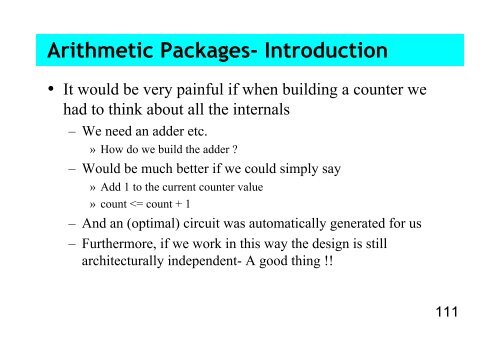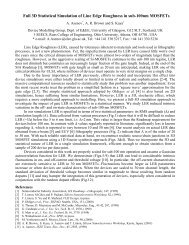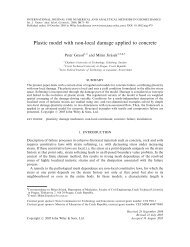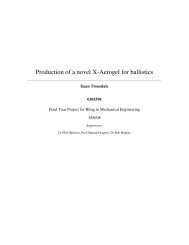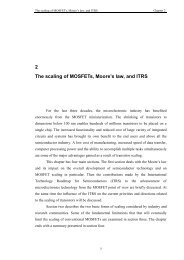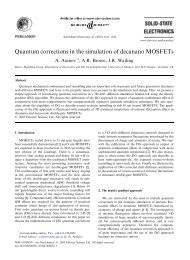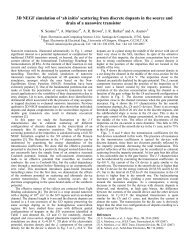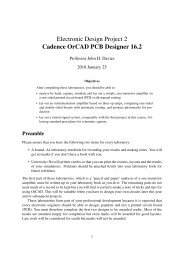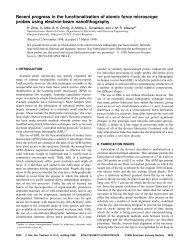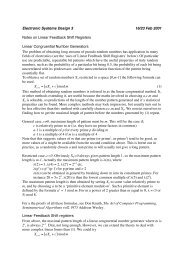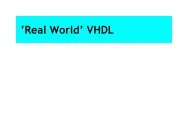05 Arithmetic in VHDL
05 Arithmetic in VHDL
05 Arithmetic in VHDL
Create successful ePaper yourself
Turn your PDF publications into a flip-book with our unique Google optimized e-Paper software.
<strong>Arithmetic</strong> Packages- Introduction<br />
• It would be very pa<strong>in</strong>ful if when build<strong>in</strong>g a counter we<br />
had to th<strong>in</strong>k about all the <strong>in</strong>ternals<br />
– We need an adder etc.<br />
» How do we build the adder ?<br />
– Would be much better if we could simply say<br />
» Add 1 to the current counter value<br />
» count
<strong>Arithmetic</strong> Package Overview- I<br />
• <strong>VHDL</strong> offers a number of packages which provide<br />
common arithmetical functions<br />
– Addition (+)<br />
– Subtraction (-)<br />
– Multiplication (*)<br />
– Division (/)<br />
– Comparison (=, >,
<strong>Arithmetic</strong> Package Overview- II<br />
• There are a number of different packages that exist for<br />
historical reasons<br />
– STD_LOGIC_ARITH, std_logic_signed, std_logic_unsigned<br />
– NUMERIC_STD (IEEE)<br />
• We will only consider ‘NUMERIC_STD’ as it is the only<br />
standard package which is def<strong>in</strong>ed on all commercial<br />
synthesis and simulation tools<br />
– Tools must provide a common set of arithmetical functions<br />
– Synthesis result (gates and how they are connected) will change<br />
with synthesis tool, but functionality will not<br />
113
Declar<strong>in</strong>g <strong>Arithmetic</strong> Signals & Variables<br />
• NUMERIC_STD offers 2 data types<br />
– SIGNED, UNSIGNED<br />
– These are declared <strong>in</strong> a similar method to ‘std_logic_vector’<br />
– Can be used to ‘declare’ signals, variables, even ports <strong>in</strong> an entity<br />
• UNSIGNED<br />
– Assumes that only positive values are go<strong>in</strong>g to be used<br />
– Example declaration<br />
signal count: unsigned (3 downto 0)<br />
– This creates a signal used for stor<strong>in</strong>g values 0 -> 15<br />
114
Declar<strong>in</strong>g <strong>Arithmetic</strong> Signals & Variables<br />
• SIGNED<br />
– 2’s complement form, with MSB used as a sign bit<br />
– Example declaration<br />
signal count: signed (3 downto 0)<br />
– Creates a signal used for stor<strong>in</strong>g the values -8 -> +7<br />
Integer<br />
Signed<br />
-8 1000<br />
-1 1111<br />
0 0000<br />
+7 0111<br />
115
Representation of Signed/ Unsigned<br />
• Signed/ Unsigned values are represented us<strong>in</strong>g a subset of<br />
std_logic_vector<br />
– I.e. ‘0’, ‘1’ <strong>in</strong> each bit<br />
• However, cannot perform comparisons, assignments etc.<br />
directly with std_logic<br />
– We need to use conversion functions (see later)<br />
116
<strong>Arithmetic</strong> Package Functions- I<br />
• For a detailed list of functions (and their operations) see<br />
the program list<strong>in</strong>g from ‘NUMERIC_STD.VHD’ this is<br />
the official IEEE package<br />
• How do I read the package header ?<br />
• Consider the function Id: A.6<br />
function “+” (L: UNSIGNED; R: NATURAL) return UNSIGNED<br />
UNSIGNED + NATURAL = UNSIGNED<br />
117
<strong>Arithmetic</strong> Package Functions- II<br />
• Signed <strong>Arithmetic</strong> Functions:<br />
Function Argument 1 Argument 2 Returns<br />
+<br />
signed signed signed<br />
signed <strong>in</strong>teger signed<br />
-<br />
signed signed signed<br />
signed <strong>in</strong>teger signed<br />
• i.e. functions to add/ subtract signed numbers<br />
– Note <strong>in</strong>teger as a +ve/ -ve argument for signed op’s<br />
118
<strong>Arithmetic</strong> Package Functions- III<br />
• Unsigned <strong>Arithmetic</strong> Functions:<br />
Function Argument 1 Argument 2 Returns<br />
+<br />
unsigned unsigned unsigned<br />
unsigned<br />
natural<br />
unsigned<br />
unsigned<br />
unsigned<br />
unsigned<br />
-<br />
unsigned<br />
natural<br />
unsigned<br />
• i.e. functions to add/ subtract unsigned numbers<br />
– Note natural as a +ve only argument s<strong>in</strong>ce no notion of sign<br />
119
<strong>Arithmetic</strong> Package Functions- IV<br />
• Comparison functions:<br />
Function Name Argument 1 Argument 2 Returns<br />
=<br />
/=<br />
Equal<br />
Not equal<br />
unsigned<br />
unsigned<br />
><br />
<<br />
Greater than<br />
Less than<br />
signed<br />
natural<br />
signed<br />
unsigned<br />
boolean<br />
>=<br />
<strong>Arithmetic</strong> Package Functions- V<br />
• Resize functions<br />
– Used for resiz<strong>in</strong>g a signed/ unsigned value<br />
– Useful if we want to extract carry bit etc.<br />
Function Description Argument 1 Argument 2 Returns<br />
resize<br />
Resize argument<br />
unsigned<br />
signed<br />
natural<br />
(new size)<br />
natural<br />
(new size)<br />
unsigned<br />
(new size)<br />
signed<br />
(new size)<br />
• Example<br />
newvalue = resize(oldvalue, 5)<br />
121
<strong>Arithmetic</strong> Package Functions- VI<br />
• Simple conversion functions<br />
– Used to convert <strong>in</strong>teger/ natural numbers to and from signed/<br />
unsigned<br />
Function Description Argument 1 Argument 2 Returns<br />
to_<strong>in</strong>teger<br />
Convert to<br />
<strong>in</strong>teger<br />
unsigned<br />
signed<br />
natural<br />
<strong>in</strong>teger<br />
to_unsigned<br />
to_signed<br />
Convert to<br />
unsigned<br />
Convert to<br />
signed<br />
natural<br />
<strong>in</strong>teger<br />
natural<br />
(size)<br />
natural<br />
(size)<br />
unsigned<br />
(size)<br />
signed<br />
(size)<br />
122
<strong>Arithmetic</strong> Package Functions- VII<br />
• Conversion to/ from std_logic_vector<br />
– Used to convert signed and unsigned values to and from<br />
std_logic_vector<br />
» Really just copies each bit<br />
Function Description Argument Returns<br />
unsigned<br />
Convert to<br />
unsigned<br />
std_logic_vector<br />
unsigned<br />
signed<br />
Convert to<br />
signed<br />
std_logic_vector<br />
signed<br />
std_logic_vector<br />
Convert to<br />
std_logic_vector<br />
unsigned<br />
std_logic_vector<br />
std_logic_vector<br />
Convert to<br />
std_logic_vector<br />
signed<br />
std_logic_vector<br />
123
Mak<strong>in</strong>g the Package Visible<br />
• At the top of the <strong>VHDL</strong> source file, the l<strong>in</strong>e<br />
use ieee.numeric_std.all<br />
Library Name<br />
Package Name<br />
• is added<br />
• This makes the package (functions, data types, etc.)<br />
‘visible’<br />
124
<strong>Arithmetic</strong> Package Example- I<br />
• Some concrete examples of the use of the arithmetic<br />
package !<br />
• Simple counter<br />
– Counts up to certa<strong>in</strong> value then resets back<br />
– Only <strong>in</strong>crements if <strong>in</strong>put ‘<strong>in</strong>c’ is set to ‘1’<br />
CLK<br />
INC<br />
COUNT 0000 0001 0001 0010 0011 0100 0000<br />
No change when <strong>in</strong>c = ‘0’<br />
125
<strong>Arithmetic</strong> Package Example- II<br />
• <strong>VHDL</strong> process<br />
process (CLK,RESET)<br />
beg<strong>in</strong><br />
if RESET=‘1’ then -- reset (asynchronous)<br />
<strong>in</strong>ternal_count
<strong>Arithmetic</strong> Package Example- III<br />
• Architecture def<strong>in</strong>ition<br />
use ieee.numeric_std.all;<br />
architecture BEHAVIOR of UPCOUNTER is<br />
signal <strong>in</strong>ternal_count : unsigned (3 downto 0);<br />
beg<strong>in</strong><br />
-- see previous slide for process<br />
count
<strong>Arithmetic</strong> Packages- Conclusion<br />
• Have given an overview of the numeric package and the<br />
functions which it conta<strong>in</strong>s<br />
• These are widely use for counters etc.<br />
• Can be used to generate many different arithmetic circuits<br />
(e.g. multipliers etc.) though it may be better to design<br />
these for the given application as the target after synthesis<br />
may be <strong>in</strong>efficient<br />
128


